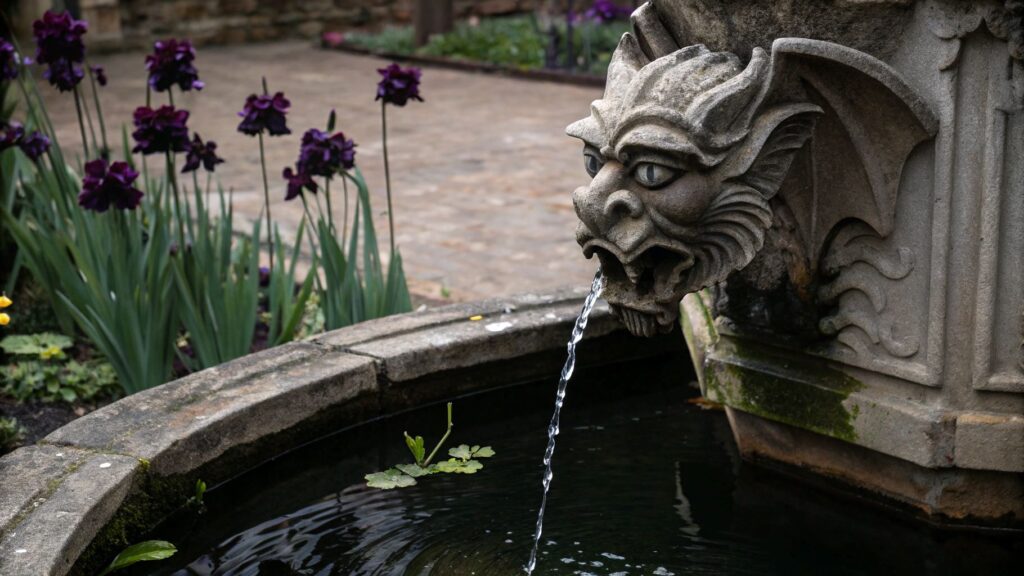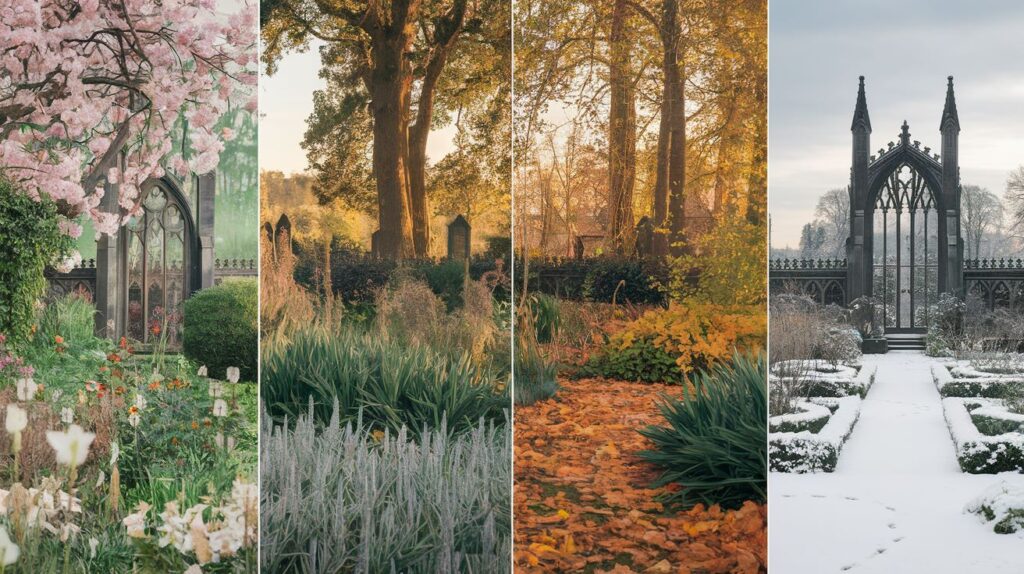
Gothic landscaping is a unique way to create a dramatic and mysterious outdoor space. It brings the dark romance of gothic architecture into your garden. This style uses plants, flowers, and decorations to make a moody and enchanting atmosphere. Let’s explore how you can transform your yard into a gothic wonderland.
Choosing the Right Plants for Gothic Landscaping

The key to gothic landscaping is picking plants that look dark and mysterious. You want to create a feeling of old, overgrown gardens from spooky stories. Here are some plants that work well:
Dark-leaved plants: Look for plants with deep purple or almost black leaves. These create a moody backdrop. Some good choices are black mondo grass, dark coleus, and purple basil.
Vines and climbers: Vines add a wild, overgrown look. They can cover walls and fences to make your space feel like a secret garden. Try plants like ivy, clematis, or moonflower vines.
Spiky plants: Plants with pointed leaves or thorns add a touch of danger to your gothic garden. Consider using plants like black elderberry, barberry, or even small cacti.
Flowers for a Gothic Garden

Flowers can add pops of color to your gothic landscape. But you’ll want to stick to colors that fit the mood. Here are some flower ideas:
Dark flowers: Look for flowers in deep purples, dark reds, and even black. Black dahlias, dark sunflowers, and black petunias are great choices.
White flowers: White flowers can add a ghostly touch to your garden. They also stand out nicely against darker plants. Try white roses, lilies, or moonflowers.
Night-blooming flowers: Plants that bloom at night add to the mysterious feel of a gothic garden. Evening primrose and night-blooming jasmine are good options.
Creating Gothic Garden Structures

To really bring your gothic landscape to life, you’ll want to add some structures. These can be both functional and decorative. Here are some ideas:
Gothic-style arches: Arches are a key part of gothic architecture. You can use them to create entrances to different parts of your garden. Cover them with climbing vines for an overgrown look.
Wrought iron fences and gates: Black wrought iron adds a classic gothic touch. Use it for fences, gates, or even as plant supports.
Stone elements: Large stones or rock formations can make your garden feel like an old graveyard. You could even add fake tombstones for a spooky touch.
Lighting for Your Gothic Landscape

The right lighting can make a big difference in a gothic garden. It can create shadows and highlight certain areas for a spooky effect. Here are some lighting tips:
Lantern-style lights: Use black metal lanterns to light paths. These give off a soft, flickering light that adds to the gothic mood.
Uplighting: Place lights at the base of trees or structures. This creates dramatic shadows and makes your garden look mysterious at night.
Moonlighting: This technique mimics the effect of moonlight shining through trees. It creates a soft, dreamy effect in your garden.
Water Features in Gothic Landscaping

Water features can add sound and movement to your gothic garden. They also reflect light in interesting ways. Here are some ideas:
Dark pools: A small pond with dark bottom can look like a bottomless pit. Add some lily pads for a swampy look.
Fountains: A stone fountain with gargoyle spouts fits perfectly in a gothic garden. The sound of trickling water adds to the atmosphere.
Fog machines: For special occasions, a fog machine can make your garden look extra spooky. The mist rolling over dark plants creates a truly gothic scene.
Adding Gothic Garden Decor

The right decorations can really bring your gothic landscape to life. Here are some ideas:
Gargoyles and statues: Place these around your garden for a classic gothic look. They can act as focal points or hide in shadowy corners.
Sundials and old clocks: These add a sense of time standing still to your garden. Look for ones made of dark metal or stone.
Antique furniture: An old bench or chair can make a great place to sit and enjoy your gothic garden. Look for pieces with intricate carvings or peeling paint for an aged look.
Maintaining Your Gothic Landscape

Once you’ve created your gothic garden, you’ll need to take care of it. Here are some tips:
Let it grow: A slightly overgrown look fits the gothic style. Don’t be too neat with your pruning.
Add mulch: Dark mulch like black bark chips can make your soil look rich and mysterious.
Plant in layers: Use tall plants in the back, medium ones in the middle, and short ones in front. This creates depth and makes your garden look fuller.
Seasonal Changes in Your Gothic Garden

Your gothic garden can look different throughout the year. Here’s how to embrace the seasons:
Spring: Add some dark spring bulbs like black tulips or deep purple crocuses.
Summer: This is when your night-blooming plants will shine. Enjoy the scent of evening primrose on warm nights.
Fall: Add some pumpkins or gourds for a spooky harvest feel. Dark-leaved plants often look their best in fall.
Winter: Leafless trees and frost can make your garden look extra gothic. Add some outdoor lighting to enjoy the stark beauty.
Creating a Gothic Seating Area

Every garden needs a place to sit and enjoy the view. Here’s how to make a gothic seating area:
Choose the right furniture: Look for dark metal or weathered wood pieces. Ornate designs work well in a gothic setting.
Add comfort: Use dark cushions or throws to make your seating area cozy. Deep purples or rich reds work well.
Create privacy: Use tall plants or trellises to make your seating area feel secluded and mysterious.
Finishing Touches for Your Gothic Landscape

To really bring your gothic garden to life, consider these final touches:
Sound effects: A small, hidden speaker playing soft, spooky music can add to the atmosphere.
Wind chimes: Choose deep-toned chimes for a haunting sound in the breeze.
Bird feeders: Attract ravens or blackbirds to add to the gothic feel. Just be sure to use feeders that keep out pests.
Creating a gothic landscape is all about setting a mood. With the right plants, structures, and decorations, you can turn your outdoor space into a mysterious and enchanting retreat. Whether you go all out with a full gothic theme or just add a few spooky touches, your garden is sure to stand out. So embrace the dark side of gardening and create your own gothic paradise!



